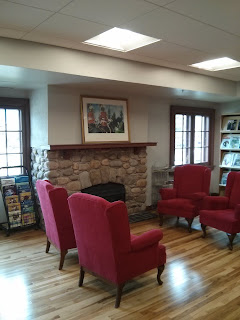Lethbridge Public Library did a really good community engagement campaign called "Have a Seat". It was good for two reasons:
First, they came up with a great way to talk to the community. They got a red leather chair and they took it around to community events, the local pool, wherever they could find people, and invited the public to sit down and consider one question: "How do you fit a community into a library?" I love this! The chair is a vivid, symbol of the campaign that catches attention and invites people to engage. Once they are seated, they are in a posture that naturally invites lingering and contemplation.
The question is really good too. I love how they limited it to one open ended question rather than a survey. The question is open ended but it is also somewhat complex, requiring some thought to understand; and it is subtly leading, suggesting that fitting the community into the library is the issue at hand.
They talked 700 people. They took a different approach with "community builders," sitting them in the chair and interviewing them (asking a series of questions). Very thoughtful way of extending the visual metaphor of the chair into different types of engagement.
The second thing they did really well was analyzing and compiling the results. You don't get any quantitative information with one open ended question, so how do you crunch the data? They identified what they called "story themes", common refrains which surfaced over and over again, and they gave them compelling names. There were six of them:
First, they came up with a great way to talk to the community. They got a red leather chair and they took it around to community events, the local pool, wherever they could find people, and invited the public to sit down and consider one question: "How do you fit a community into a library?" I love this! The chair is a vivid, symbol of the campaign that catches attention and invites people to engage. Once they are seated, they are in a posture that naturally invites lingering and contemplation.
The question is really good too. I love how they limited it to one open ended question rather than a survey. The question is open ended but it is also somewhat complex, requiring some thought to understand; and it is subtly leading, suggesting that fitting the community into the library is the issue at hand.
They talked 700 people. They took a different approach with "community builders," sitting them in the chair and interviewing them (asking a series of questions). Very thoughtful way of extending the visual metaphor of the chair into different types of engagement.
The second thing they did really well was analyzing and compiling the results. You don't get any quantitative information with one open ended question, so how do you crunch the data? They identified what they called "story themes", common refrains which surfaced over and over again, and they gave them compelling names. There were six of them:
- We Love the Library!
- People Want More of the Good Stuff (less of the not so good)
- Well…I Didn’t Know That!
- By the Way I’m Having Just a Little Trouble Using the eResources
- Since My Life is Filled to the Max (it makes a difference to me that the Library is close to where I live or work)
- It’s Important that the Library be a Community Hub (a place to learn, discuss, interact, have fun and sometimes expand who we are).











